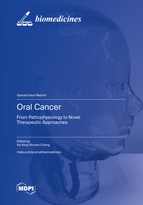Oral Cancer: From Pathophysiology to Novel Therapeutic Approaches
A special issue of Biomedicines (ISSN 2227-9059). This special issue belongs to the section "Cell Biology and Pathology".
Deadline for manuscript submissions: closed (31 August 2023) | Viewed by 22278
Special Issue Editor
Interests: oral oncology
Special Issues, Collections and Topics in MDPI journals
Special Issue Information
Dear Colleagues,
Oral cancer is a commonly occurring head and neck cancer, 90% of cases of which are diagnosed as oral squamous cell carcinoma (OSCC). This lethal malignancy is a debilitating disease that impacts patients’ physical appearance, causing disfiguration and devastating their self-esteem. Despite improvements in diagnostic facilities and patient management, the prognosis of OSCC remains poor.
Histologically, OSCC is derived from a multistep mechanism known as oral carcinogenesis, which progresses from normal epithelium to hyperplasia, followed by dysplasia and carcinoma in situ and precedes the development of invasive squamous cell carcinoma. Caused by exposure to carcinogens, such as smoking and excessive alcohol drinking and HPV infections, this multistep mechanism is characterized by mutations related to copy number alteration and epigenetic modifications.
Precision medicine based on genomic profiling is also becoming more prevalent. It relies on the genetic information of individual patients or specific cancer cells and how their genes interact with each other and the environment. This method has the potential to provide more effective treatment strategies as approaches can be customized for the specific genetic profiles of patients. The completion of the TCGA HNSCC database has led to the development of new therapeutic approaches and targeted therapies. Lately, immune checkpoint inhibitors have been recognized as one of the standards of care in HNSCC. However, although treating invasive SCC is crucial, the implementation of prevention strategies to preclude malignant transformation has been useful in clinical management.
Topics of interest for this Special Issue include, but are not limited to:
- Precision medicine, i.e., targeted therapies that inhibit oral carcinogenesis and tumorigenesis mechanisms;
- Combination of novel therapeutic approaches with standard-of-care regimens in OSCC;
- Biomarkers, i.e., predictive and prognostic markers for therapeutic approaches.
For this Special Issue of Biomedicines, entitled “Oral Cancer: From Pathophysiology to Novel Therapeutic Approaches,” we are inviting the submission of original articles, review articles, systematic reviews, and meta-analyses considering oral carcinogenesis, tumorigenesis, and novel therapeutic approaches as well as biomarkers for treatment efficacy. New experimental clinical results for HNSCC are also welcome.
I look forward to receiving your contributions.
Dr. Vui King Vincent-Chong
Guest Editor
Manuscript Submission Information
Manuscripts should be submitted online at www.mdpi.com by registering and logging in to this website. Once you are registered, click here to go to the submission form. Manuscripts can be submitted until the deadline. All submissions that pass pre-check are peer-reviewed. Accepted papers will be published continuously in the journal (as soon as accepted) and will be listed together on the special issue website. Research articles, review articles as well as short communications are invited. For planned papers, a title and short abstract (about 100 words) can be sent to the Editorial Office for announcement on this website.
Submitted manuscripts should not have been published previously, nor be under consideration for publication elsewhere (except conference proceedings papers). All manuscripts are thoroughly refereed through a single-blind peer-review process. A guide for authors and other relevant information for submission of manuscripts is available on the Instructions for Authors page. Biomedicines is an international peer-reviewed open access monthly journal published by MDPI.
Please visit the Instructions for Authors page before submitting a manuscript. The Article Processing Charge (APC) for publication in this open access journal is 2600 CHF (Swiss Francs). Submitted papers should be well formatted and use good English. Authors may use MDPI's English editing service prior to publication or during author revisions.
Keywords
- oral carcinogenesis
- oral tumorigenesis
- OSCC
- ICI
- mutation
- biomarkers
- chemoradiation
- targeted therapies
- cisplatin
- preclinical models







